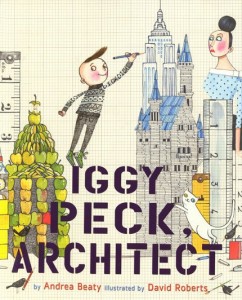 Long have I loved Andrea Beaty’s picture book series about a bear named Ted (grab Doctor Ted, Firefighter Ted, and Artist Ted from your local library and prepare to be charmed.) Then, I saw sitting on the shelf by the Ted books this gem, just waiting to tie in perfectly with science, math, and phonological awareness lessons.
Long have I loved Andrea Beaty’s picture book series about a bear named Ted (grab Doctor Ted, Firefighter Ted, and Artist Ted from your local library and prepare to be charmed.) Then, I saw sitting on the shelf by the Ted books this gem, just waiting to tie in perfectly with science, math, and phonological awareness lessons.
Iggy Peck, Architect written by Andrea Beaty and illustrated by David Roberts will grab young readers on page 1:
“Young Iggy Peck is an architect
and has been since he was two,
when he built a great tower – in only an hour –
with nothing but diapers and glue.”
The story about a young boy who loves to build and saves the day with his architectural skills is told in fantastic rhyme. (Hello, Common Core Standard of Phonological Awareness!) But the beauty of this book is that after you’ve used it in reading lesson, it inspires all kinds of science, art, and math extensions.
When his class is stranded on a small island, Iggy teaches his classmates how to construct a suspension bridge from “boots, tree roots and strings, fruit roll-ups and things”. After sharing Iggy Peck, Architect, pull out Bridges by Seymour Simon to learn more about suspension bridges and how they work (and pat yourself on the back for Integrating Knowledge and Ideas, you Core Standard wizard.) You may choose to forgo tree roots and boots, but challenge your students to plan and construct a suspension bridge, perhaps between two tables, with materials like string, paper, straws, etc. Students can use graph paper like David Roberts did when they draw up their plans, measuring actual distances and then scaling the distances down on paper before they build. Your students will be measuring, counting, drawing, predicting, and revising as they work. Keep architecture books like Bridges! Amazing Structures to Design, Build, and Test by Carol A. Johmann and Elizabeth J. Rieth, or the wonderful David Macaulay books on hand for those inspired by Iggy Peck. As Miss Lila Greer, the teacher in Iggy Peck, Architect realizes:
“There are worse things to do when you’re in grade two
than to spend your time building a dream.”
For more information about the author, go to andreabeaty.com.
For more information about the illustrator, go to davidrobertsillustration.com.



